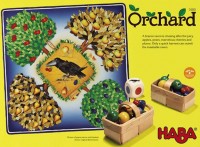
Orchard

Family Focus Review
These reviews provide insight on some of the best games for families with young gamers. Written from a parent’s perspective for a fun and educational family game night!
Overview
Looking for a great way to introduce young ‘uns to board gaming? Look no further! Orchard‘s simple dice-rolling and fruit-collecting will have your kids wanting to play again… and you’ll be able to enjoy yourself as well!
Set Up
Orchard‘s large board is placed in the middle of the table (or floor if you’re playing with toddlers) and holds most of the game’s contents. There are four trees illustrated on the board around a large raven; all 10 pieces of each of the four fruit types (apples, cherries, pears and plums) are placed on the corresponding tree.
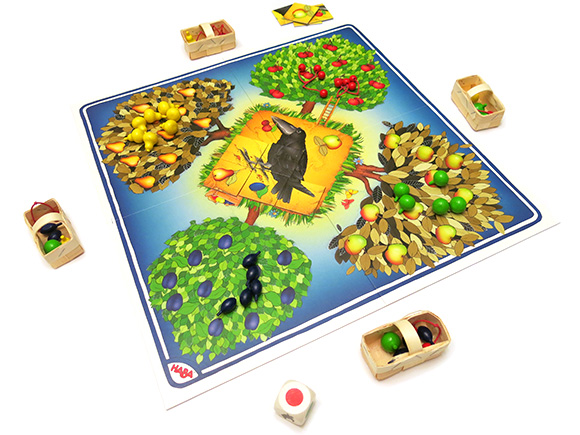
The raven puzzle and giant die are set close to the board for easy access. Each player claims a small wicker basket, and you’re ready!
Gameplay
Each turn is made up of two simple actions: roll the die and do what it instructs.
Four faces of the die are colored to match the fruit on the trees (green, red, yellow and blue). If you roll one of these faces you will claim one piece of like-colored fruit from the proper tree and place it into your basket. One face of the die is an illustration of a basket – if this is rolled, you get to pick any two pieces of fruit remaining on the board (these don’t have to come from the same tree).
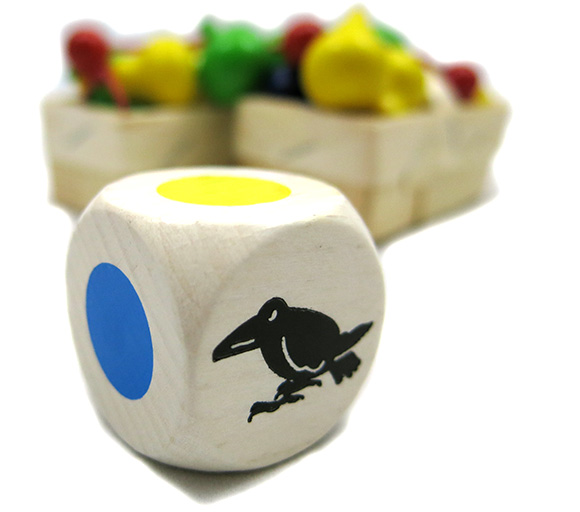
The final die face is an illustration of the raven. If this is rolled one piece of the raven puzzle must be placed. The raven puzzle contains 9 pieces… and if it gets completed the raven eats the rest of the fruit from the trees and the players lose!
Players will alternate rolling dice and collecting fruit (or building the raven puzzle) until either all fruit is collected (players win) or the raven steals what’s left.
Components
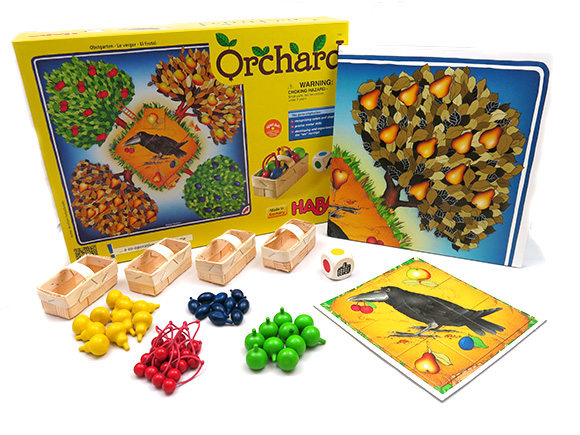
The fruit pieces are high quality painted wooden bits much bigger than typical board game bits (on account of not wanting children to swallow them). The painted wooden die is enormous.
There are four small wicker baskets for players to collect fruit in – these are authentic and cute, but a child’s misplaced foot will crush them so care must be taken.
The raven puzzle, while acceptable quality cardboard, is a little disappointing. The pieces are just squares rather than interlocking puzzle pieces… considering puzzle-building is a big part of development for children at the lower end of the publisher’s recommended age range, it seems like an opportunity missed.
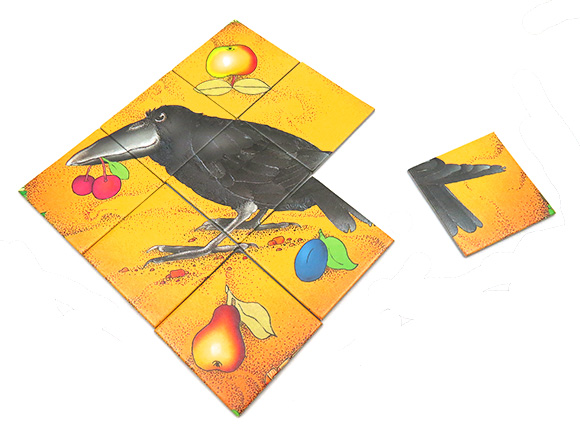
Finally, the board does a nice job of keeping everything situated and helps children visualize the theme.
Learning Curve
For children or adults, the rules of the game take one minute to understand. There is a neat little piece of child development embedded in the game play that will take younger children some time to grasp – namely which fruit are best to select when the basket is rolled on the die.
Educational Value
The Orchard box calls out three areas of development provided:
- Recognizing colors and shapes
- Precise motor skills
- Developing and experiencing the “we” concept
Orchard relies on recognition of blue, red, yellow and green. I’m not real certain why the box claims shape recognition – while the wooden fruit pieces are different shapes, those shapes are not represented on the die (each color is just a large dot) – meaning children are only tying the die roll to the correct fruit piece via color.
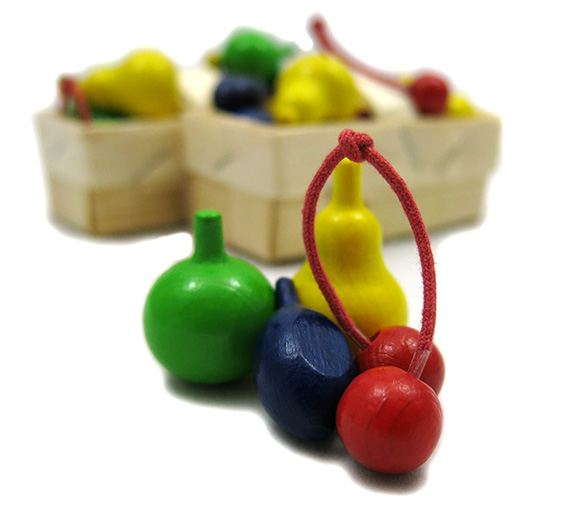
The motor skill development mentioned comes from rolling the die… but this thing is so big and unwieldy that it is an accomplishment when smaller hands learn how to properly roll it. It takes some practice.
As for developing the “we” concept, this really can’t be overstated. Most children’s games are competitive, and it’s not a lot of fun finding out your child is a poor loser when they’re this young. In Orchard you have to root for other’s rolls and cheer them on when the raven is nearly built. Your children will look at you as a teammate against that greedy raven, and celebrating a victory with them is very gratifying.
An important piece of development not captured on the box is learning about comparative value. As adults, we would all choose to take the most abundant fruit when the basket is rolled – but a 3-year-old’s first impulse is going to be to take the fruit of the color they like best (or the cherries, because they’re cute little pieces connected by a string). Eventually they’ll take an interest in why mommy and daddy are picking one plum and one apple over the others, and they’ll slowly catch on to the idea of getting the most out of a roll.
For The Parent
Orchard is a game you will cherish playing with your 3-to-6 year old. It is time very well spent with them. The only thing a parent needs to keep in mind is that you will lose on occasion, and the best way to curb a young child’s disappointment with that is to play again and again until that pot-bellied raven is chased off!
Final Thoughts
The box states plainly that this game is intended for adults to play with children between the ages of 3 and 6, and this age range was clearly well-researched. A child much older will lose interest, as they’re capable of handling more challenging mechanics than rolling and collecting. But kids in this age range will love Orchard – and parents will love playing it with them.
While the game’s mechanics are simple, they will seem plenty complicated when playing with a little one. It’s very rewarding as a parent to see your children begin to grasp the concept of taking the most abundant remaining fruit when they roll a basket. If playing with a child at the lower end of the age range, this will take some time.
While Orchard won’t be a first option for your adult game nights, it is fun as an activity with those precious little ones you hope to mold into tomorrow’s gaming partners!
User Reviews (0)
Add a Review for "Orchard"
You must be logged in to add a review.

Be the First to Add a Review!